As a rule, I’ve never been a big fan of articles with clickbait titles proclaiming that the contents feature “20 Great Horror Movies You’ve Never Seen” or “17 Things You Never Knew About The Making of MANNEQUIN TWO: ON THE MOVE.” It’s a headline that assumes that (a) the writer of the article is more knowledgeable than the readers of the headline and (b) that the information conveyed within it isn’t common knowledge. Who the heck does this article writer think they are? I, the world’s foremost enthusiast of MANNEQUIN TWO: ON THE MOVE, am offended by this insult to my cinematic knowledge and shall not be clicking, as the mere headline has shown to be a viper’s pit of lies.
With that said, and with a firm knowledge that Daily Grindhouse’s readers consist of some of the most well-read, erudite fans of horror cinema in all of the cult film website kingdom, I should be reticent to type the next paragraph. But I am not.
I’m about to tell you about a 16mm, feature-length horror film featuring mad scientists, vampires, werewolves, detectives, witches, and secret passages, shot in 1985, that you’ve never seen. In fact, I’d be willing to bet you’ve never even heard of it. Yes, even YOU, Mr. “I Own BLONDE DEATH on Beta” and Ms. “I Own The Clown Outfit Used in TALES OF THE QUADEAD ZONE.”
That film is THE SPECTRE FILES: DEATHSTALKER.
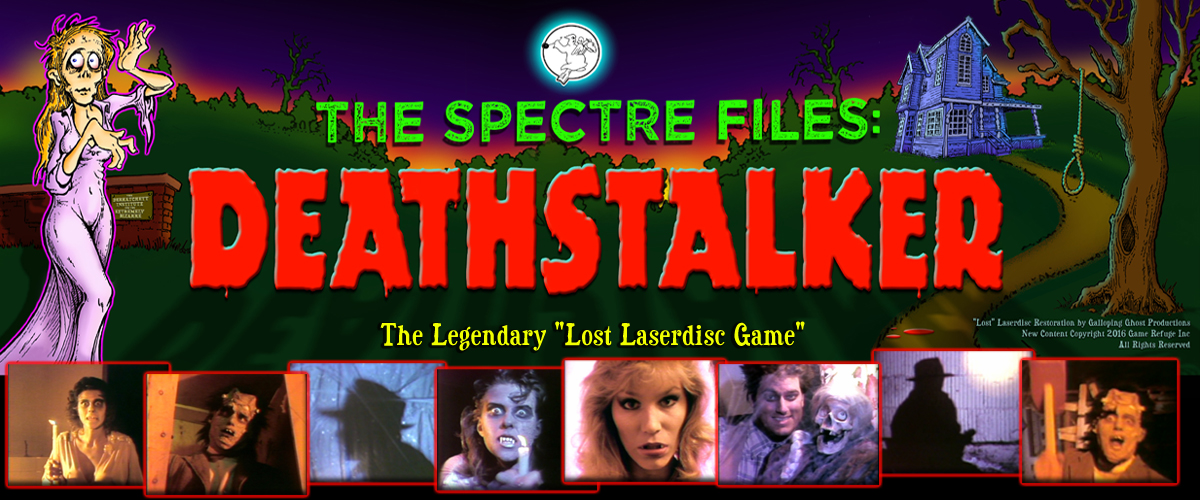
And here’s the thing – unless you’re in the Chicago area, you can’t see it. And even if you are, it’s going to take quite a bit of effort the see the whole thing. You’ll have to play for quite a while.
Play? Oh, right. I buried the lead on that. THE SPECTRE FILES is more than just a movie. It’s a video game.
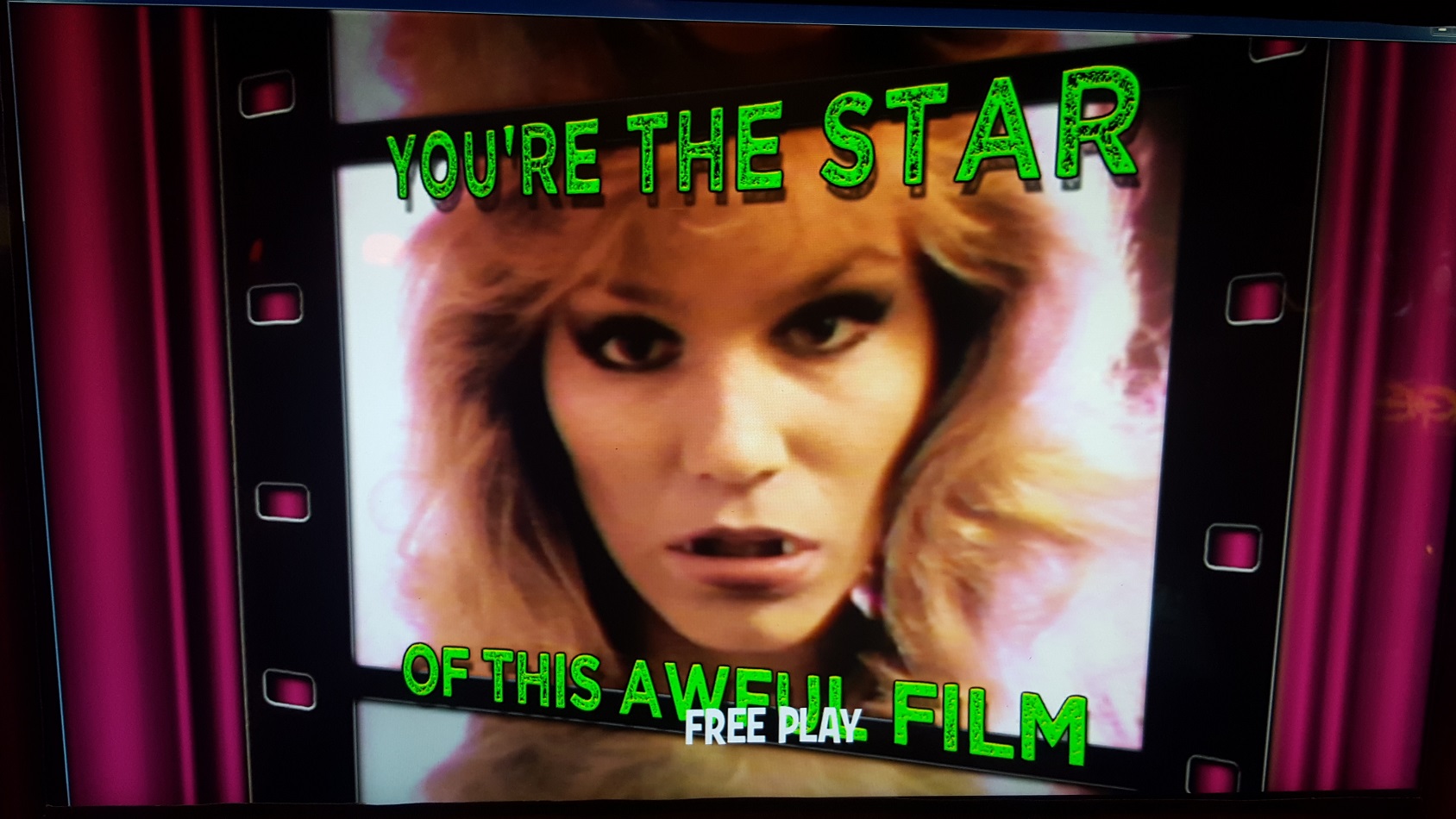
THE SPECTRE FILES is the brainchild of Brian F. Colin, the game designer responsible for such notable quarter-suckers as RAMPAGE, GENERAL CHAOS, XENOPHOBE and ARCH RIVALS. The story of detective Ed Spectre and his quest to discover what happened to local woman Buffy McGuffin by taking a journey into an abandoned psychiatric institute, THE SPECTRE FILES was planned for release in 1985, and while the footage was shot and edited, the game wasn’t completed until last fall, when Galloping Ghost Productions teamed with Colin to finish the game after three decades of the footage sitting in Colin’s basement.
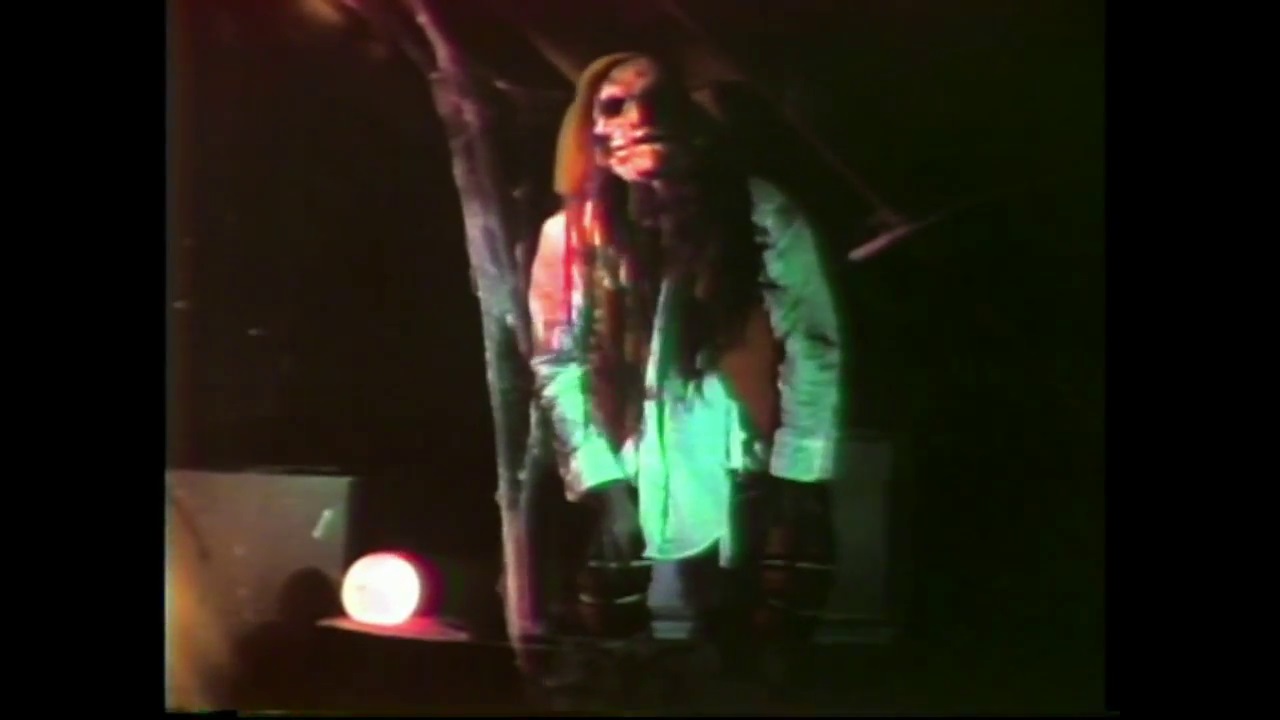
The fact that SPECTRE is a game heavily influenced by classic horror films is no accident, once you know Colin’s background. Colin had come from a film background originally, shooting 8mm film in high school and attending Southern Illinois University with an emphasis on animation. “I was a traditional filmmaker all through high school,” Colin explained when we talked to him about the project and his career, “and I found that in college the only difference was in high school you got your friends who will show up for four or five days of doing a movie where in college you get people dropping out after day two and you’ve got to scrap the project and start over. So I turned to animation because I could control everything.”
(Above: HALLOWEEN AT SIU CARBONDALE, a short film by Brian Colin)
The culmination of his animation training can be seen in the short film IN SEARCH OF A PLOT (below), a downright amazing nine minutes that combines multiple animation styles and genres in a clever, funny portrait of the creative process. “That film won a number of international awards. I did that in my junior year in College down at SIU (Southern Illinois University).”
While the film was appreciated, it didn’t result in a film career. “I won a lot of awards, had dinner with Chevy Chase, Hugh Hefner’s parrot bit me on one occasion – I took it all around New York, to the National Lampoon… it was pretty much the same story. ‘This is brilliant! This is creative! You should have no trouble finding a job… somewhere else.’”
Instead, Colin found himself taking his artistic talents to a brand new field – video games. “I came back here [to Chicago] and answered an ad at Bally/Midway thinking I was answering an ad for a pinball backglass artist, but they wanted an animator for video games. Right place, right time – wasn’t even all that enthused because the industry was at the PAC-MAN level, but the first thing that I worked on [DISCS OF TRON] showed me that if you pushed up against the box, you could go anywhere. It kinda got me all inspired and was kinda responsible for the next 35 years of my life. I was just the animator on [DISCS OF TRON], but if you happen to know that game, it was such a departure, with the silver veneer and the environmental cabinet and the surround stereo and everything. It was so good that that was my first game, because I was skeptical about what I was doing in the industry, but working on that had got me to realize that man, if you’re just willing to push against the box, this could go anywhere. ”
The transition from hand-drawn animation to the still-developing computer animation was a painful one – quite literally. “They only had in-house tools that some techs down in the lab built as art tools, and I kid you not, we had these little microswitches and microdials that the button was the size of a pinpoint, and you had to dial up your RGB value on three separate dials, and each click was painful to click to the next on your thumb, and you had to push on this little, tiny thumb button that was the size of a pinhead to actually paint the pixel in that spot, so literally it was a painful transition until they got some people in there who said, ‘No, no, let’s give these guys trackballs, let’s give these guys ergonomic controls.”
Once the actual methods of creating the animation became more user-friendly, Colin found that he could use his previously-honed animation instincts well, allowing him to use the humor and more out-of-the-box concepts he’d used in his film school days. “Once we got halfway decent controls, the physical transition got a whole lot easier and once I realized they were going to let me push the limits on everything I did, that kept me happy creatively and I realized, okay, it’s not going to be pen and ink, which is my style, but I can make cartoon characters in a video game, which prior to doing it myself, I wasn’t seeing any. And I can get comedy, and I can get emotion, so things like ZWACKERY and RAMPAGE and stuff like that.”
The biggest benefit, however, was the return time on a piece of work. “I’m creating art and animation that was fairly limited, two or three frames, maybe if you were really lucky you got to do a six or eight-frame walking animation, but I’d get done with it, I’d walk it across the hall to the programmers’ cubicle across the way, and I could see it working in 20 minutes. That was a huge part of what made the whole animation process in video games fun for me was the immediacy. I could see it animating, I could say, ‘Oh, I’m going to add a little backwards motion to that before it goes up, and now it’s got a nice circular motion in his walk’, and I go across and make the fix, I hand it him, he doesn’t even have to do any more code, he just loads in the new files, and now it looks perfect. And then a little later on, the tools they created let us check the animation right where we were and I didn’t even have to walk across the hall. So coming from a film process, getting it processed, waiting for your work print, getting it back, going ‘oh crap, am I going to go in and redo that or just cut this out’ – the immediacy of video games was extremely gratifying to someone whose creative process needs to move forward, and when it moves forward that fast, the passion that you feel for what you’re doing just builds and builds. Where with film, just the waiting to get the film back before you could edit, all of that, it was a huge plus.”
The 1983 release of the Don Bluth-animated DRAGON’S LAIR sparked an onslaught of LaserDisc-based video games, where players could decide the actions on screen by making quick movements with the joystick. While DRAGON’S LAIR and its immediate offspring were gorgeous to look at, they weren’t much to play, quickly sucking up two quarters at a time to frustrated players. Bally was anxious to get in on the action. “I hated this ‘little light spark goes off one side and you’ve gotta snap your wrist to the right on you die,” Colin explained. “And then Bally got into the LaserDisc games but they just licensed some really bad, ‘hey let’s take a camera and move it down this cardboard canyon and we’ll call it ASTRON BELT.’ They were pretty bad.” ASTRON BELT, utilizing footage from films including STAR TREK II, BATTLE BEYOND THE STARS, and MESSAGE FROM SPACE, was a medium-sized hit, but failed to become the phenomenon that DRAGON’S LAIR, released earlier in the year, had been.

Colin, however, came to Bally’s producers with a plan, utilizing his film background. “Especially in the early days, they were pretty good about, if you were passionate enough and you made your case, they would let you try stuff. And I said, look, myself, and other animators Steve Alsted and Sharon Perry, we did a haunted house interactive film adventure in Super 8. And I showed that to management and I said, ‘I’m an award-winning filmmaker’ and I said look, you give me a small budget, I can do a love-action haunted house detective mystery and to prove it, I had the first and only time I tried programming, in assembler, I worked with a couple of the guys there, they helped me set up an interactive text adventure. Unlike DRAGON’S LAIR or any game where you make the wrong move and you die, it was an honest-to-goodness text adventure where there maybe three or four choices on the screen and some might kill you, and some might be the best choice, but others might be the second-best choice that takes you down a path that will let you discover new things and find new things you can use later.”
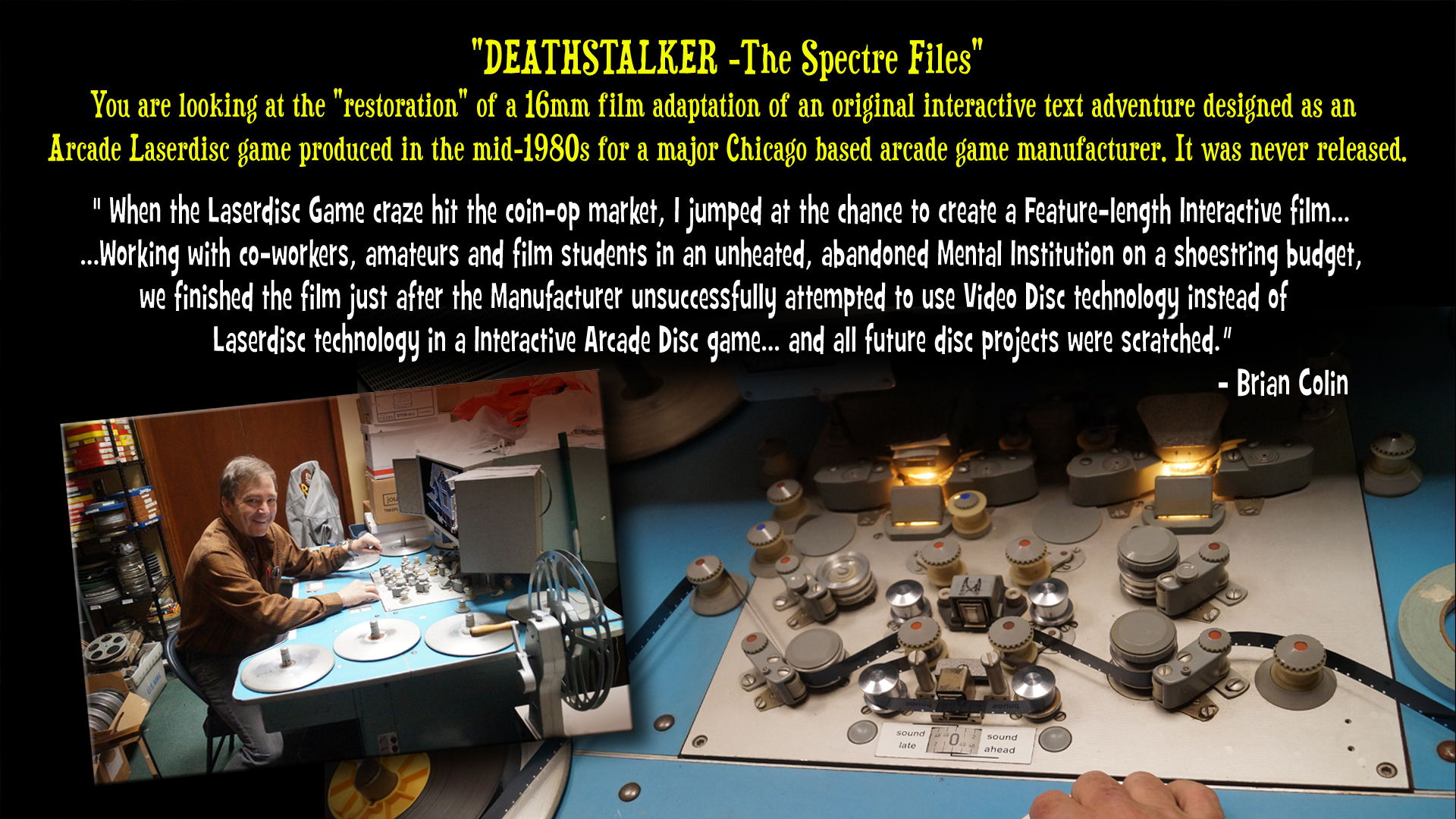
That project became THE SPECTRE FILES, a tongue-in-cheek horror game where the player would control the actions of Detective Ed Spectre, determining what to do with the various monsters in his path by selecting one of three choices. The live-action “interactive movie” concept had been done before, starting with the 1967 Czech film KINOAUTOMAT (which was a bit of a cheat, as while the audience could make decisions, the characters always ended up on the same path), but THE SPECTRE FILES would mark the first time this would be done based on the decisions of a single player.
The film would be very much influenced by Colin’s love of classic horror, a recurring theme in his work that became more evident with the following year’s RAMPAGE. “I was a famous Famous Monsters of Filmland subscriber in my youth. My favorite horror films growing up were the ones that were – I was a bit of a chicken as a kid, if it was a real horror film like THE EXORCIST or THE TEXAS CHAINSAW MASSACRE, I didn’t want to see it. I liked the horror films where it was all just about mood and the cool shots of this monster or that character, and so even though this was a haunted house-based detective murder mystery, I tried to vary it because it was for the arcade, there’s not a ton of blood, there’s not gore, it’s more the ‘50s and early ‘60s horror films. I had a lot of fun with it.”
Bally agreed, and Colin began working on the project, shooting the film footage in 16mm. “It was very much a throwback to ZORK and that kind of thing, and they said yes, so they gave me a small budget and I put an ad in the [Chicago] Tribune that said ‘Vampires Wanted, No Experience Necessary’. I got a lot of struggling actors that came out and were kind enough to work for nothing, basically. I had a film crew made up of students from SIU, they took the semester off and got a semester credit, and we filmed in an abandoned nursing home in Chicago on the north side of the city. A 13-story tall abandoned mental institution that had electricity but no heat during the coldest February on record. That provided a number of challenges, but we did that for a month. So basically for a month, I checked out of my normal duties and three days out of the week I would be shooting in this looney bin. “
Despite being technically for a video game, the SPECTRE FILES shoot had the same issues that any low-budget genre film would have. “You learn things doing that that you’d never think you’d learn. We were shooting scenes and the actresses drop their coats and they’re wearing their lingerie that they’re supposed to be in. We’d shoot the scene and everyone would throw their coats back on. We’re in this one room for about an hour and one of my photographers just yells ‘Cut,’ and I’m like, ‘What’s the matter?’ and he’s like, ‘Look’, and I look up and it’s snowing inside the place because our breath had condensed and frosted on the ceiling, and when we turned the lights on, it melted the frost on the ceiling but it was so cold in that building that it had turned to snow before it hit the ground. I kid you not! Those were the conditions.“
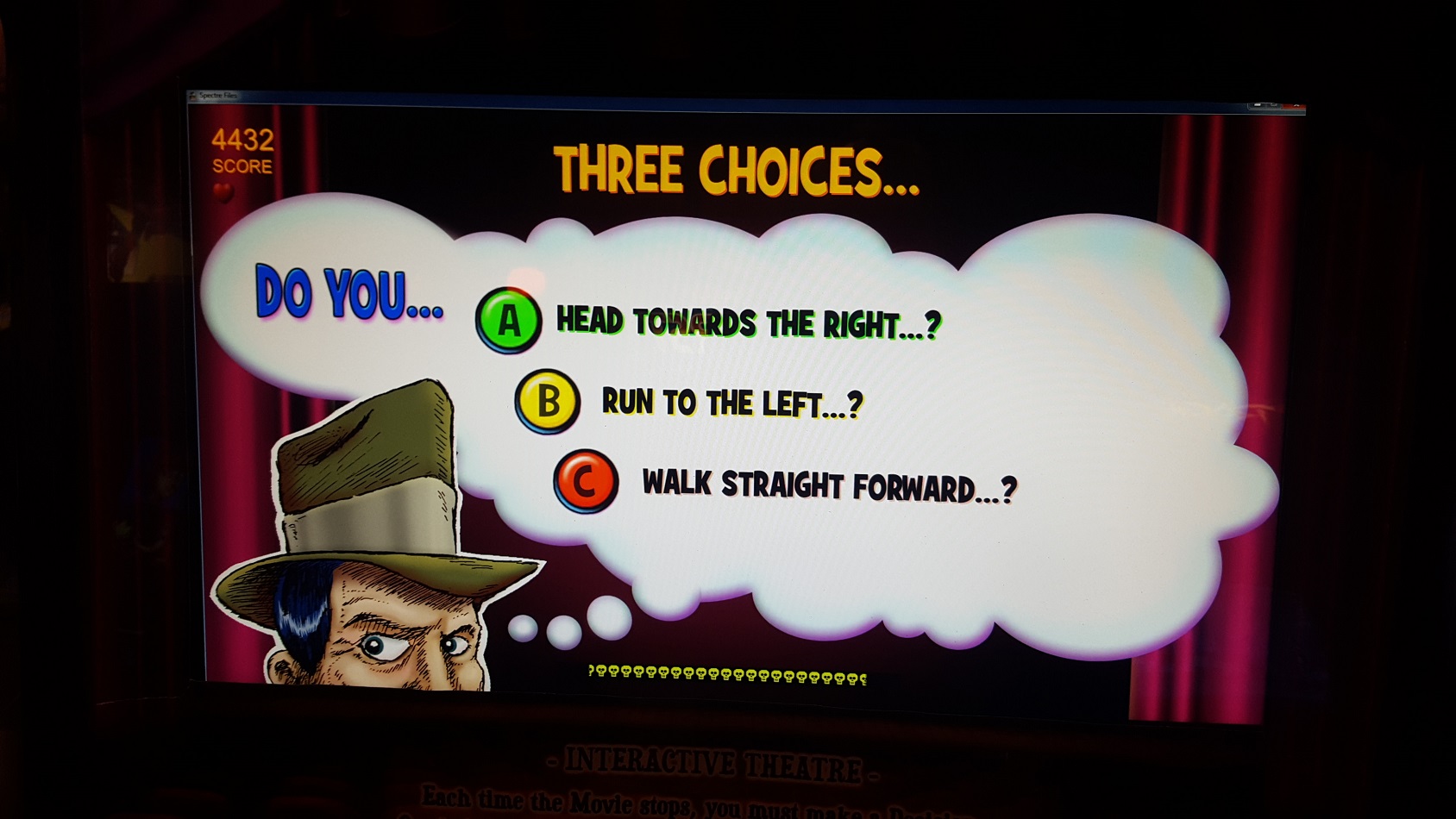
Among those who worked on the project was Sharon Perry, another animator at Bally, who’d assisted in the original short. “Sharon was the gal that basically put the bow on Ms. Pac-Man. She was one of the first artists they had in their newly-formed development group. She taught me how to use the tools when I was hired. She was great, and she’s the first female vampire you come up against. I don’t want to spoil too much, but if you walk in the front door you’re going to meet her right away. She was terrific, she was a great sport. She was terrific as Vampiress #1.”
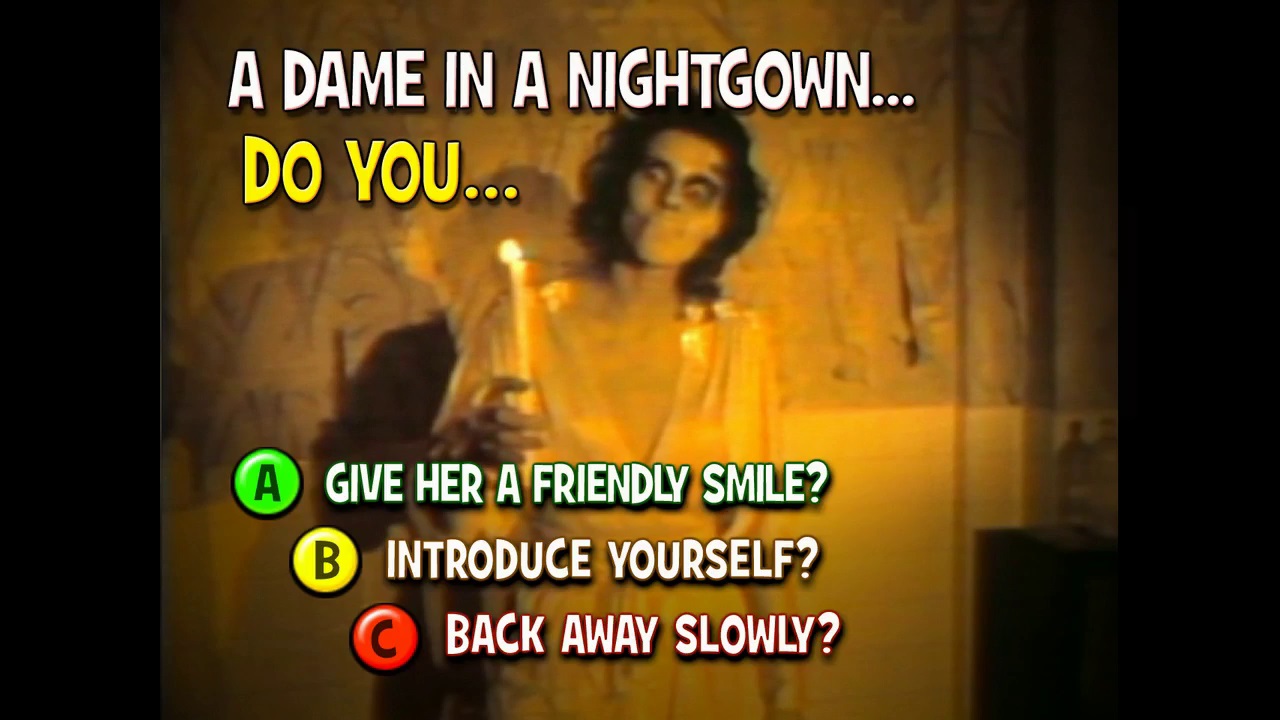
“Now some production things didn’t work that good, like originally the effect of throwing holy water in her face, I put baking soda under the makeup all over her face, and we kind of laid her back in a rig and I had the camera pointed at her, and it’s like ‘Okay, here’s what we’re going to do, it’s going to perfect, we’ll show your skin bubbling and everything else, so it’ll be great. So take a deep breath and keep your eyes closed, and we’ll sprinkle a little vinegar to react with this baking soda on your face.’ For any filmmakers out there thinking they should use this trick, lemme tell you: When the cold vinegar hit her face, she involuntarily inhaled, and you could see it in film frame by frame, these twin jets of vinegar shooting up her nose, which has disastrous effects. If you’ve ever tried snorting vinegar, it’s got to be up there with Tide pods. It’s not anything I would advise anyone to do. So you won’t see that particular cut in the film. We found a different way to do it. We were just young and stupid and trying everything. She was a great sport. She even talked to me after that.”
The nature of the project meant that unlike a traditional narrative, the script had to account for multiple paths and coverage needed to serve double duty. “Back in the day, especially in the arcade, we had set schedules we had to live by. So a typical game development process would be that we want to get 100% of it done by this date, but as you’re going through the development, you keep going, ‘Oh, but we should add this’ so by the time that date is coming closer and closer, you’re working from eight-hour days to sixteen-hour days, because in a production facility, you don’t miss the deadline. So that was the way I was trained. And with this one, I had the script and I knew what I wanted to do, but on set, shooting, it was like, ‘Okay, take some cutaways here, take another shot of her walking away, is it in the script, no, but take that shot anyway.’ And it wasn’t video, it was film, so I had to be conscious of the cost, but to take as many cutaways as I can and see if I can work them in later.”
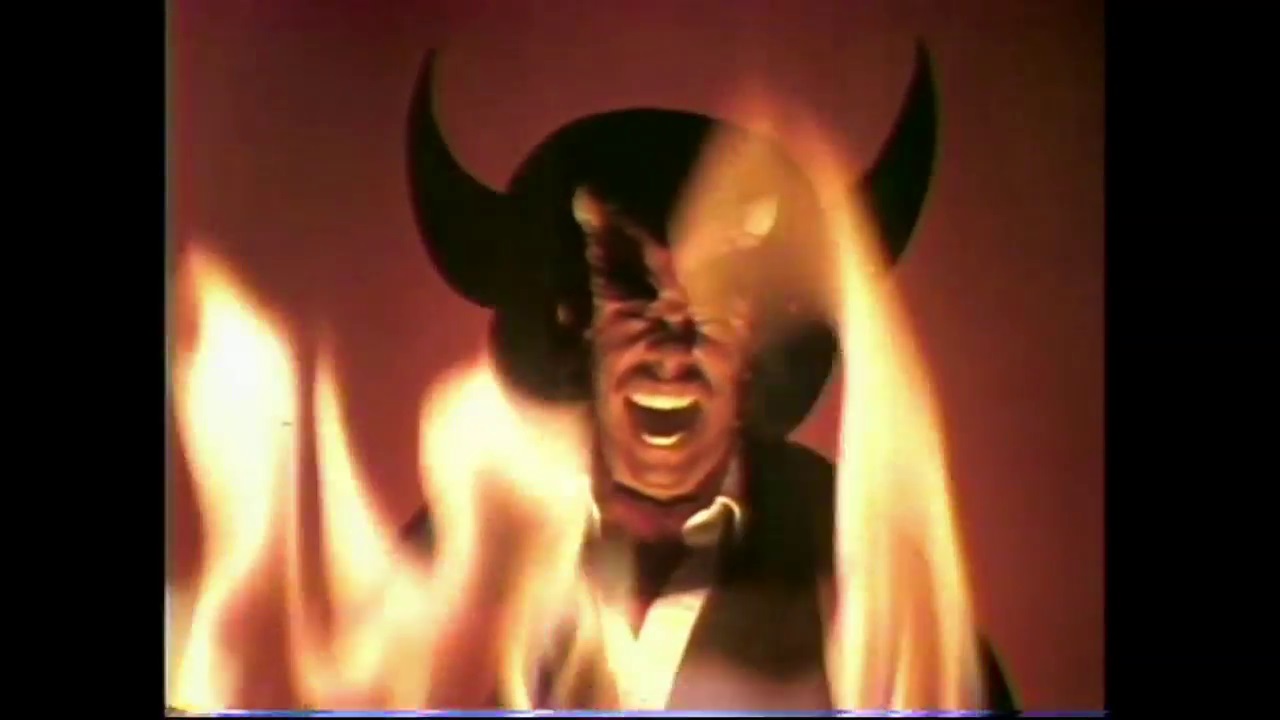
“It was fun in a lot of regards. We had a scene in the original scripted out in which we had a dragon, and we were using kerosene and so we splashed a little kerosene and so we splashed a little kerosene on this one door and it wasn’t the right effect, and I’m trying rubber cement, and that’s too clear, so we splashed a little more kerosene, and kerosene is slow-burning, so we figured we were doing okay, until we realized we are now standing in a pool six feet wide of quarter-inch kerosene, and it’s burning downing from the little spot on the door I was trying to take a picture of, and the floor is now engulfed. And it’s like, ‘Save the camera! Open the windows!’ Fortunately it was night, so nobody spotted the black smoke as it came out of the place, and we were able to control it. And we were about on the 11th floor, too. So you learn things not to do. It’s a low-budget film production. It was a wonderful experience.”
After completion, Colin edited the film into a single, feature-length test to show the company. “We took it back, edited it, I actually got a Steenbeck, and we edited everything down into about an hour and ten minute film start to finish. But of course, it was non-linear, because the choices are going to be made and you jump around. And then the two stereo tracks were – in many cases, in each of the scenes there would be different audio tracks between the left and right channel because we’d play the left track if they made this choice, but if they got there by this way, we’d play the right track. Picture the staircase for example – it might say, ‘And I saw a stairway leading up to somewhere’ if they came at it from below, otherwise they’d come down it from above, and it’d be, ‘And I looked back at the stairway that brought me to this hellish place’ or something. That kind of silliness.”
This edit, however, would be where production on the game was halted. “So it was very involved, the script was insanely detailed, and hundreds upon hundreds of choices, and just around the time we got done with editing, Bally had their big NFL FOOTBALL debacle. Someone in management decided that if LaserDisc games were possible, and they had the NFL license, they were going to do clips from football games and you could be the quarterback, which sounds like a great game. However, they made the choice to do Videodiscs instead of a LaserDisc to save money, and the Videodisc as people who remember the technology know, had a needle like a phonograph record. So they went into production with these things, and the first time an operator bumped them or they got jarred while playing, it turned into a four-thousand-dollar doorstop, because the disc itself would get scratched and the game would be useless. So on that embarrassment, they decided to get out of the LaserDisc side of things and I was told, ‘Glad you made the movie, but just keep it.’ And in the meantime, I’d been doing well with games like RAMPAGE and XENOPHOBE and other hits were coming along at that time. I was disappointed, but I had other things going that were going well. They weren’t too upset with me, and while I was upset with them, I put the film away and pretty much forgot about it.”
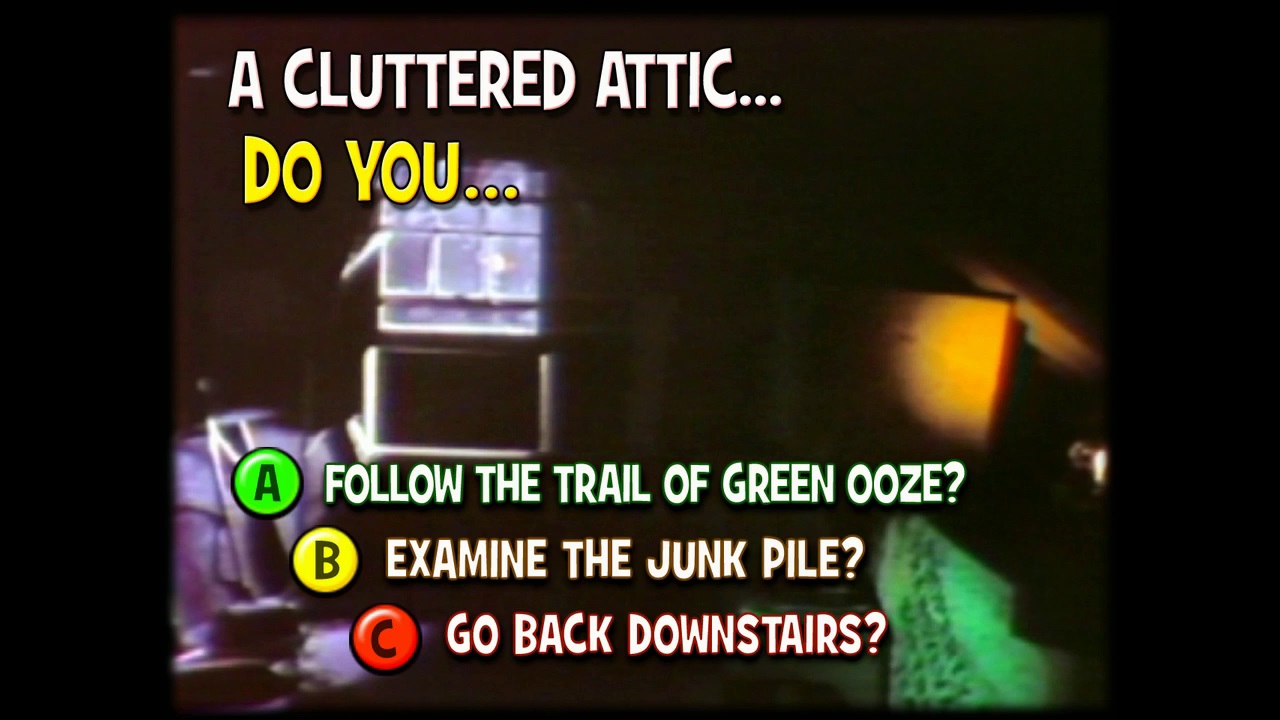
As instructed, Colin did keep the single print of the completed THE SPECTRE FILES, storing it in his basement for over 20 years, while working on a variety of other projects. Footage from the game emerged in 2007 online, after Colin created a music video for the project. “The music video on YouTube was just about the only production thing I did. I threw that out there, and I’ve had a lot of interest in it over the years, people saying, ‘What happened to this lost LaserDisc game?’”
The video uses theme music from a band called Triannan. “The composer was a guy named Jim Ruse. He lives down here in Homewood still, another Homewood resident, he was the best friend of my younger brother, and he had a band and he did the scores for a couple of my movies. I did a documentary on Halloween in Carbondale during one of its peak years, and he did a tremendous song for that. Basically, I would do the lyrics, and he’d write the songs. THE SPECTRE FILES, that music video is a delight. He plays regularly at some of the venues around town, bars and that sort of thing, on a regular basis, and it’s mainly an acoustic set, but every now and then, he’ll play a nice acoustic version of THE SPECTRE FILES theme song, which is always fun. He did a tremendous job. His band was great, and I loved what he did with it. It tried to give a hint of the story and the diversity of the story, the music video and the lyrics. He made it work as a tune.”

The game became something of a legend, an incomplete short-on-film horror game by a major developer that would have predated the FMV games and interactive oddities like I’M YOUR MAN and MR. PAYBACK of the ‘90s – and a game much wider in scope than many of the multiple path games that had emerged since. It wasn’t until Doc Mack, the founder of Galloping Ghost, one of the top arcades in the nation and then considering moving into production, got involved that THE SPECTRE FILES rise from the dead. “[Brian and I] met up to discuss a game called RAIDER’S RUN,” Mack explained, “and initially we were talking about doing GENERAL CHAOS 2 with him, and the scope of that project was larger than we had wanted to get into at the time, but he pitched this game called RAIDER’S RUN to us. It sounded like a great game, and we started talking about what else could we do. We get into this conversation, and he had invited us out to his office and showed us two unreleased prototype games, one being INTERNATIONAL TEAM LASER and the other being RC SQUARED, and he donated both of them to the arcade, and that really spawned a lot more discussions and by the time we were picking a project to do together, we’d heard about all these games that had almost came out, and one of them was THE SPECTRE FILES.”
“And he was like, ‘I think there’s a video out there somewhere,’ and I punched it up on YouTube and watched this thing and it was just an ‘80s horror movie, and it was – looking at all the games he had worked on already, you could see his humor in it. At the time, he was like, ‘It’s one that was gone and will never be’ and we were talking about it one day and he said, we shot the whole thing on 16mm, and whatever happened to that 16mm? And he said, “I think that might be in my garage somewhere.” And it quickly became like, okay, we’re going to do RAIDER’S RUN, but the condition is that we’ve gotta do SPECTRE FILES too, and he was kinda like ‘Yeah, Yeah, whatever,’ and he’s like ‘I don’t even know if that film even survived’ – there’s all these reasons why not to do it. And he went out and found all of it, and we said, we’ll cover the costs and send it off, and put it on DVD, and at least it’ll be preserved, the footage. It all kind of went from there. He sent it off, and it’s all there, and it’s like, well, now we’ve gotta make this game!”
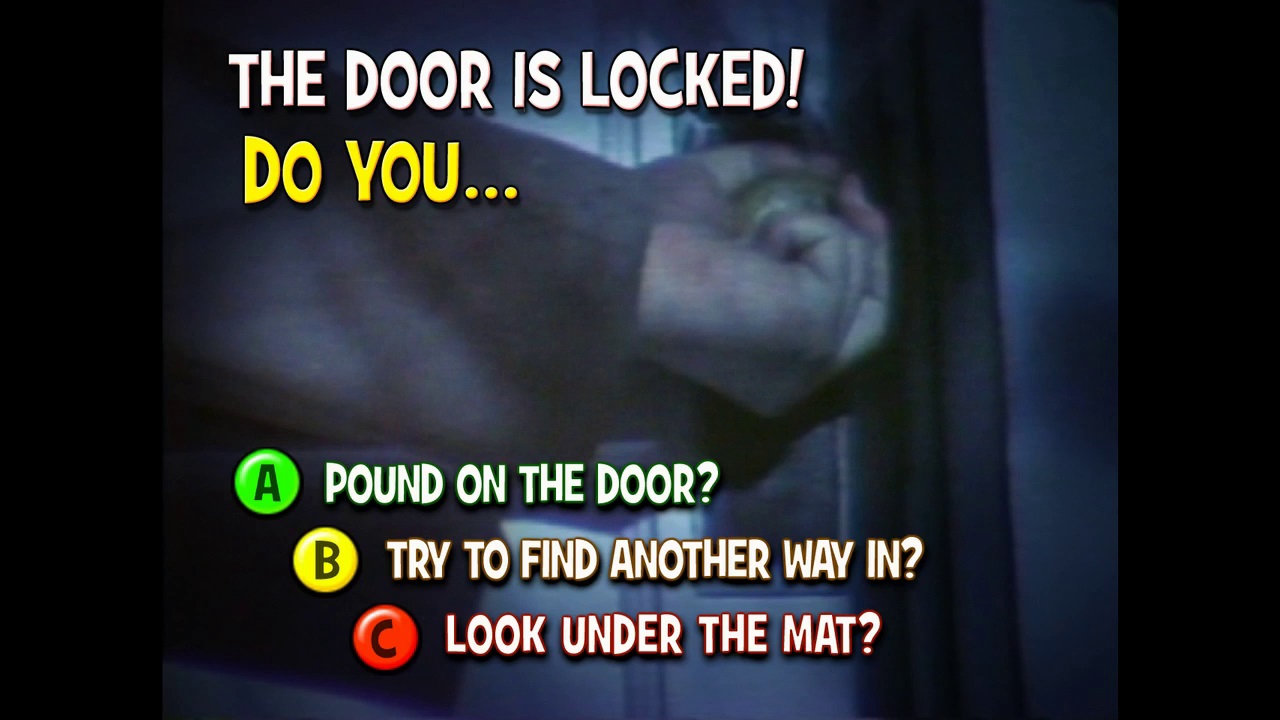
It was then a matter of actually using the footage to create the game itself, which had been planned but never initiated. “I said it was never made into a game,” Colin explained, “so we’d have to either print it as a LaserDisc and do a LaserDisc game, or I could turn it all to digital and do it on a PC-based platform, but we’d have to do everything. We’d be starting from the finished answer print, and I’d have to rewrite the script in a lot of places because I don’t have both the left and right channel. I said it’s not a trivial project, and I was already working on something for him at the time, and he basically said ‘I want you to do this as well.’”
The changes in technology meant that the process went more smoothly than it would have, had all of the editing been done on 16mm. “Now it is video,” said Colin, “so I can do duplicates and I can combine some things, and because again I didn’t have a firm date on when this needed to be done, it was incredibly intricate to begin with, because I don’t like the idea of a game designer telling the player telling the player what they’ve got to do to get to the best point. I’m much happier with a player should be able to get to the end of this with a successful or an unsuccessful end a different way every time. That’s where I saw that the thing would have likes. Somebody could still beat the game but want to come back because, ‘What do you mean, Mummy? I never saw a mummy!’ But didn’t you beat the game? Yeah, but you never saw the mummy – oh, because you didn’t talk to the butler or you didn’t jump off the stairs. And I wanted it to have dozens and dozens of paths, so a lot of that was just my own obsession with wanting to give the player, the viewer, as many possible choices and then the tricky part was making sure all your unrolled balls of yarn from a story standpoint tied back in someplace. And some of them were planned from the beginning – I knew at some point, the character was going to jumping out the window of the attic and there’d be a ladder there, and he might be able to climb down if he’s lucky, that’s going to tie into the beginning of the game, because if you walk around the house, you can find that same ladder, and maybe that’s the way to get in and not have to go in the front door because what I find behind the front door has killed me the last three times I’ve tried it. So some of that stuff was scripted, but the way it ended up, I added a lot more here in recent months of ‘Okay, and here’s one more little wrinkle.’ It’s just a giant, crazy puzzle that I’d love to say was all carefully mapped out in advance, but probably only about half of it was, and the rest, we just kind of made it up in the editing room, which… any good film is always made up in the editing room.”
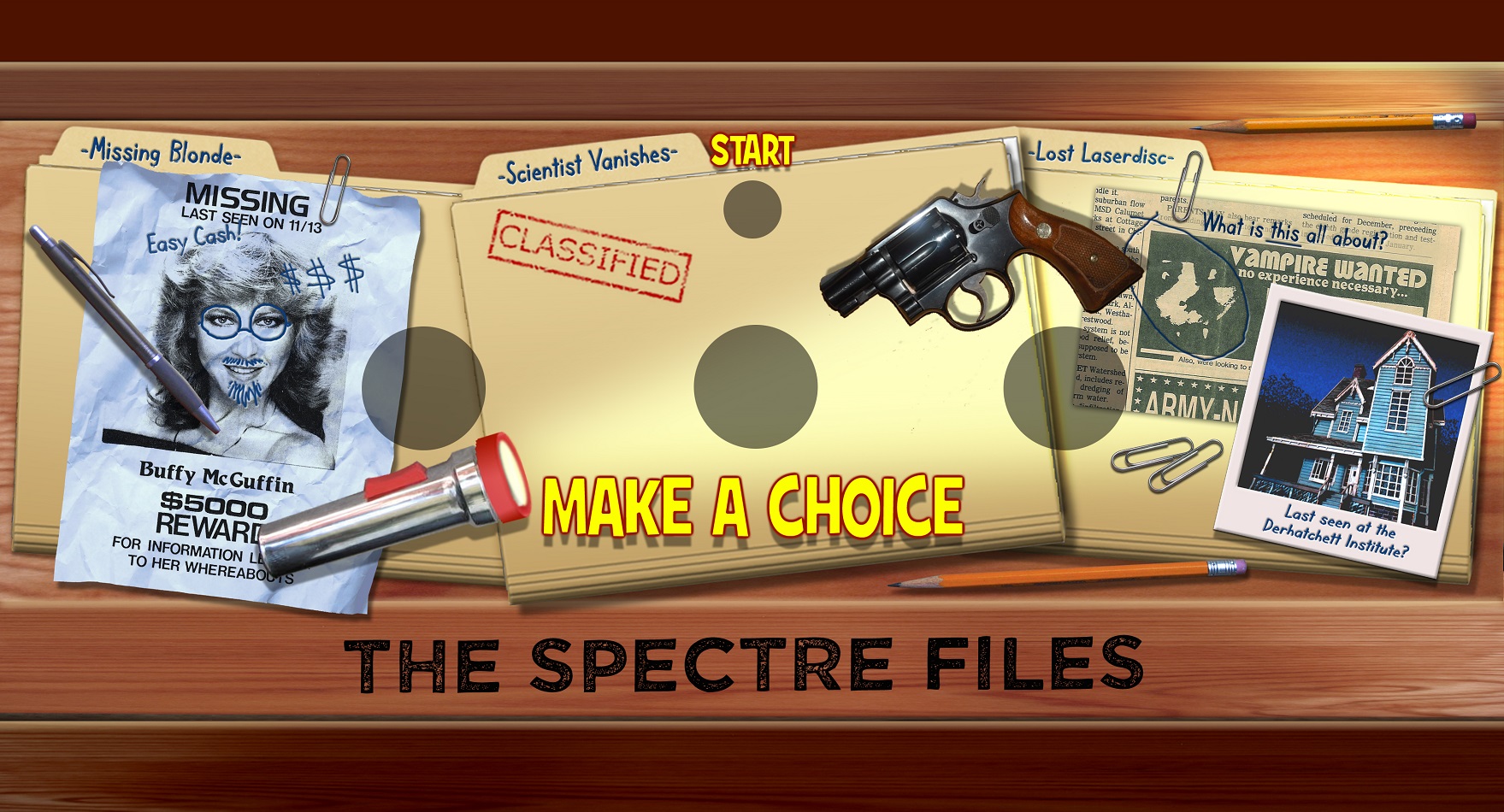
Mack had a blast with revisiting the horror tropes set up in the thirty-year-old film. “Growing up, I used get this catalog called Johnson-Smith, and it had practical jokes stuff, smoke bombs, and they had this huge mask section, with all these Halloween masks. And one of the characters was in this mask that I always wanted to get. And it’s like, There’s that mask from 1982! And it had those connections with me, and it didn’t really hit me until I was watching the video, it was like, Wow, I remember that being sold somewhere.’ And you can see how this all probably came together, and just hearing the stories about Count Jacunsky had bones for had, and he’s like, ‘Oh, we tied chicken bones to a pair of gloves,’ and that’s what they were doing in B-horror movies back in the day. It’s awesome.”
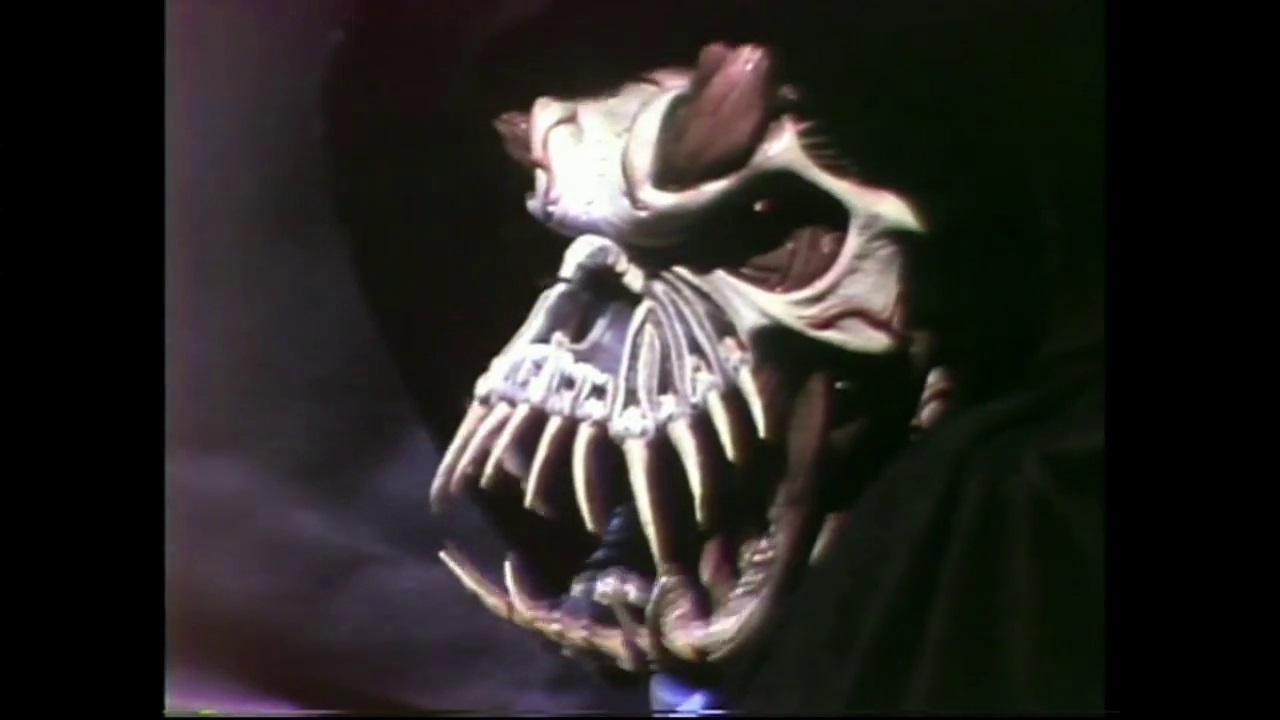
One of the big stipulations for making the game work for the arcade was that there was some sort of point system to keep players coming back, resulting in points being accumulated through various means. “One of the things that especially Galloping Ghost, with their free play all day [business method], a lot of their players are very score-conscious. I’m not a score guy, and my best-known games like RAMPAGE, you can buy in all day, so people would complain, ‘You can buy the high score!’ My job was to make a game that made money for the operator and the company, so I was like, ‘Yes, you can, and go right ahead and do it! Buy that highest score!’ But some people get very passionate about score and want to know what they have to do to get everything. And with THE SPECTRE FILES, Doc made it very clear when we were talking about restoring this never-before-existed game that he wanted a score system in there. So we decided we would give you score for the screen time for every scene you watched, you get score for that, you get score increased if you choose quickly, and the longer you play, not just beating the game, but the more diverse paths you can criss-cross from floor three to the basement to this room to this secret hallway to this secret stairway, the more you can travel, if you see more things, you get a greater score. So it’s not how fast can I get to the end and win. For people that want score, I wanted to make it, hey, you can come back and play this dozens of times and never see anything, and get higher or lower scores.”
“I mentioned ZORK earlier, and there’s a real nod to ZORK in the game because when you’re exploring around the house before you first go in, you can wander off into the forest. And it is very, very, very easy to get lost in the forest as it used to be in the old ZORK game. North, south, east, west – eventually players will find their way back, but it can happen in three moves, and it can happen in thirty moves. And they get points for that! If a player wants to sit there and be lost in the forest for twenty minutes, he’s getting points for all that time. Now, ultimately, those are little short segments, and you might have been better off just going inside and dealing with the issues inside the game, but two players competing for score, one guy says what I need to get the high score in the game is to get myself lost in the forest for a while. He wants to go do it, more power to him. I want everybody to be able to play every game any way they want. Whatever makes it fun for them.”
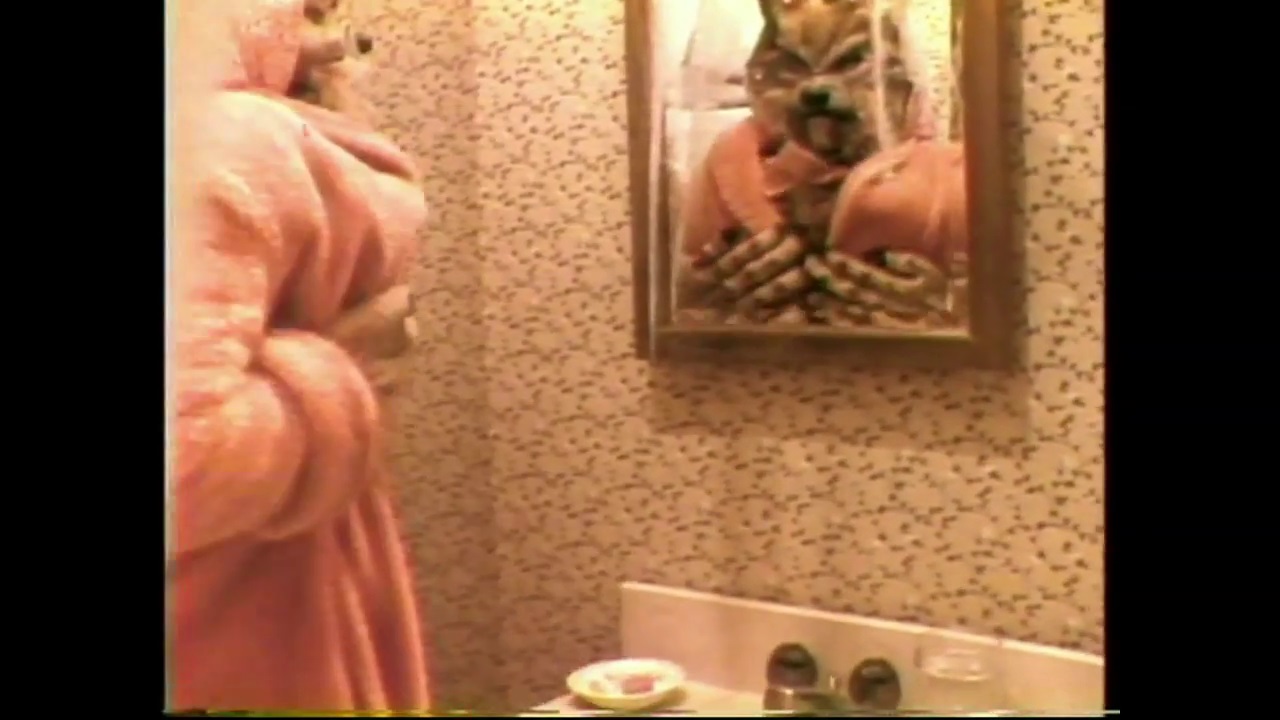
There was also the question of whether or not to use the original LaserDisc method of data storage that would have hosted the game originally. “I’m very much an arcade purist,” explained Mack, “and I wanted CRT monitors, I wanted LaserDisc, and it was kind of funny, because looking at the games Brian’s put out, his games have so many cabinet features that nobody else got to do. Like, most of his games use very unique joysticks and have 3 players, games like ZWACKERY had an elaborate stick and the spinner, and his games, for whatever reason, they really went above and beyond for what they allowed him to do. Now he’s a little bit more.. he’s like, it’s going to be 16 x 9, it’s got to be an LCD screen… his mindset is different. Even when I said we should put this on LaserDisc, he was like, you’re insane. Businesswise, he’s making the smart business decision, but that’s something that in our talks, I was all about it, and he went with the more business-sound move there, because LaserDiscs are so much maintenance and I think it was the right choice for a lot of reasons. But moving forward, we are open and looking at doing other platforms and mobile and PC releases for the game.”

The design of the visual framework for the game had changed since its original intent, altered from the concept of a more “book” type format to a more cinematic one, with Mack’s input. “Whenever [Brian] had made that video, he had put that book concept together. He said he had done a little bit of artwork for the various characters back then. As we started working with it, he had evolved, he’d want to have the lost film element, which is why he designed the cabinet to be with movie curtains. We wanted it to be as accurate to his original vision as possible. As with any game, you’ll get feedback from players, and there are some elements, like the cabinet design itself, changed a little bit. He’d designed really nice artwork, very bright, very standout-ish, but in the test of it, players thought it didn’t fit specifically because it was very cartoonish art and it was all real actors. So we adapted the cabinet slightly from the initial concept and made it to just test better. While we wanted to have his original vision intact, just like they would have back in the day, they would have kept fine-tuning and altering stuff. “
“The cabinet design, we went with the shape of the cabinet is actually based on the NFL game that cancelled Brian’s game. So often games released in the same era were put in the same cabinet, and we fortunately had one and built it up as a prototype. It was interesting, seeing the game that had his game cancelled still have an impact on its final release!”
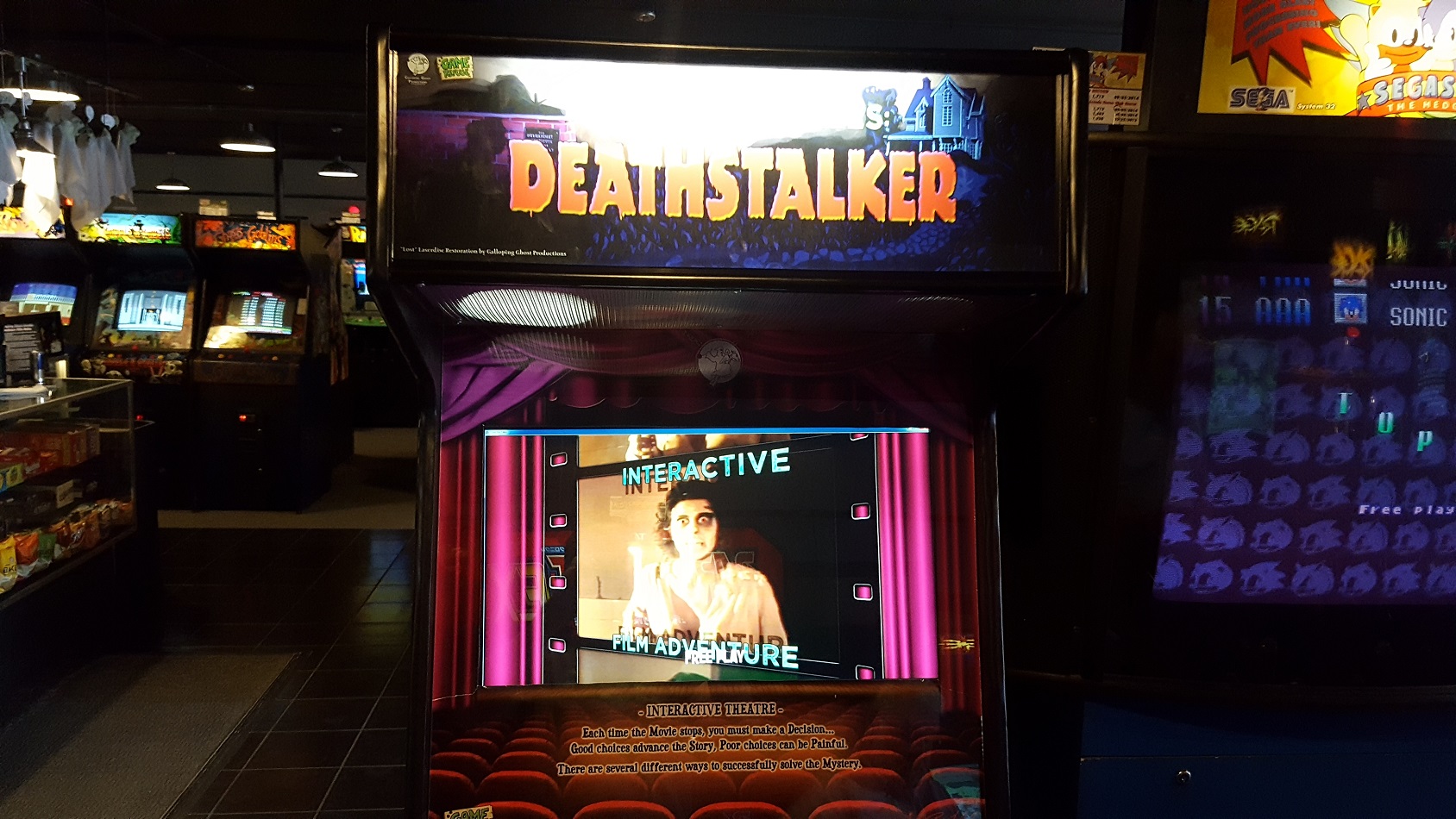
THE SPECTRE FILES: DEATHSTALKER made its debut at the Galloping Ghost Arcade in time for Halloween of 2017, and quickly became a big hit with arcade-goers – as well as Colin himself. “My understanding is that it is a huge success with the visitors at the Ghost, and everybody seems to love it, and it’s really gratifying! And I love the fact that Doc let me turn this thing into a reality, even if it was 30 years after the start. And so much more of it is poignant to me, because back then it was a low-budget parody, and by today’s standards, it holds up wonderfully. The bad puns, the terrible acting, the cheesy effects – we shot it on 16mm, and they hold up today and almost have more entertainment value today than it might have had even in the original day, just because it looks like a bad, old film! I think one of the title pages on there is ‘You are the star of this horrible movie.’”
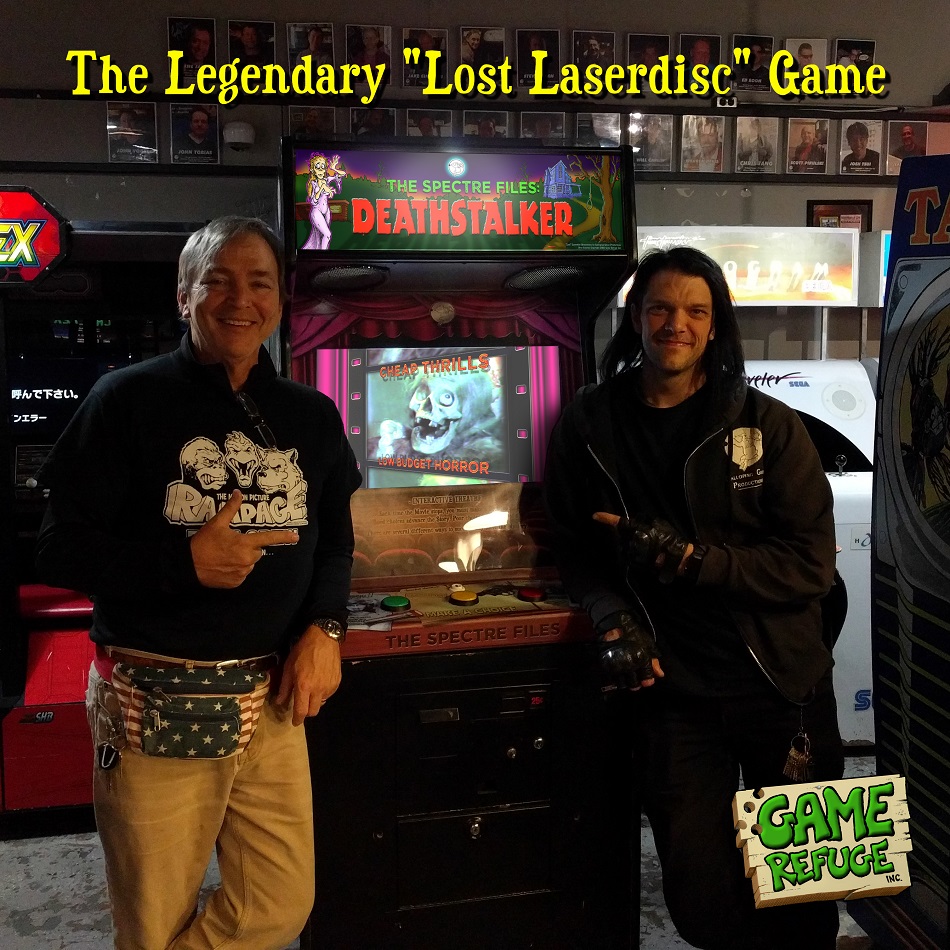
In the end, THE SPECTRE FILES may have been better off having been rejected from its original release, its vintage horror nature even more appreciated by audiences looking for some retro-scary cinematic experiences, and its gameplay no longer feeling the need to suck up quarters. “In the grand scheme of things,” Colin expounded, “I think it’s so lucky for me personally that Bally did not take the game any farther back in the day, because it would not have earned enough money to justify production. Because they were based strictly amount of money they earned on tests, and this game takes so long to play we would have had to charge at least a buck a play if not more. And I’m fairly confident we would have made a couple prototypes, one of which I would have wielded out into my basement when were done with it, but other than that, it wouldn’t have gone into production because I don’t think it would have earned enough money on a quarter basis. In today’s world, I think you could put that even for a quarter in a place that takes quarters just for the novelty of it, and it’s going to pay for itself ten times over because people are going to come in to see it.”
Mack agreed. “Looking at it as a game back then, it never would have come out. The main reason it probably never would have come out is when they put games out on test back then in 1984, it was all about earnings. That game, you’ll spend 15 minutes on it before you get killed off, even if you’re new to the game. It’s a very long-playing game. Back then they wanted you to be putting in a new quarter into the game every 30-45 seconds. If it even had been completed, they never would probably have released it due to low earnings.”
Colin is working on other projects as well, including the aforementioned GENERAL CHAOS 2. “With Game Refuge right now, we’re halfway through GENERAL CHAOS 2. I get more fan mail on that game than any game I’ve ever done. It struck a chord with players on the Sega Genesis and now with touchscreen… if you’re not familiar with the game, it was one of the first real-time strategy games. You control the squad of five different guys, each of whom had its own type of weapon, and unlike big, real-time strategy game where you’re building armies for two hours and then you get five minutes of play at the end, these were squad-based games so your squad against your friend’s squad. It’s just three and a half minutes of mania, of chaos, literally, where you’re moving your guys to where they can do the most, you’re battling over this territory, and it was intensely popular. So now the technology’s caught up to where we think we can really enhance it and do an incredible job. We started it a couple of years ago, and basically we started it, and I had a new social media guy working for us at the time who lined up nearly a dozen podcasts, the biggest podcasts around the country, I was going to do a multi-city tour, and on literally the day before I went out to meet with the Indoor Kids [Podcast] in L.A., which they’re great people, I found out I had cancer. So I had to cancel the tour, the Kickstarter never got the publicity, because I basically was out of commission. So it’s been sitting idle for about two years now, and I’m actively talking to partners right now. That is our next big project. We’ve got some other stuff we’re doing, we’re doing a board game, and we’re doing a card game app that I can’t talk about specifically because they’re for clients, but GENERAL CHAOS 2 is our number one priority right now. Getting that back on track and finishing that up. You go look at the old Kickstarter and see where it got to, and I’m really hopeful that we can finish that up this year, because that’s going to be an exciting game.”
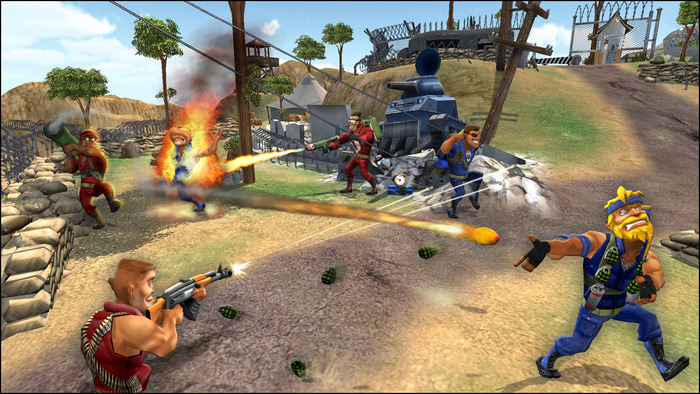
THE SPECTRE FILES itself is currently only available to play at Galloping Ghost Arcade in Brookfield, Illinois, but you may see it pop up in other locales soon. “We actually just did a ten-cabinet production run that we’re selling to other arcades and collectors,” said Mack. “We haven’t officially launched it yet, so currently it is the only location. Three of the cabinets are going to functioning arcades. It has been amazing, seeing the response to it, even with the long play times — there’s always somebody on it, because it is such a unique game. All weekend, it’s just like how it was in the ‘80s. We have a lot of games here, and that one right now is just catching all the attention because there’s nothing else like it. It’s full motion video, and everyone’s getting into it. Myself, when I was playing, Brian wouldn’t tell me how to finish it and I spent days just playing it. Even when we had a feature where we could skip the videos, the one-liners, and the humor to it, it’s fun over and over, even if it is the same video. Everyone that has spent a lot of time on it and tried getting the scoring aspect of it, they’re saying the lines with the character, almost has that ROCKY HORROR feel to it. You wouldn’t have guessed that would happen with it.”
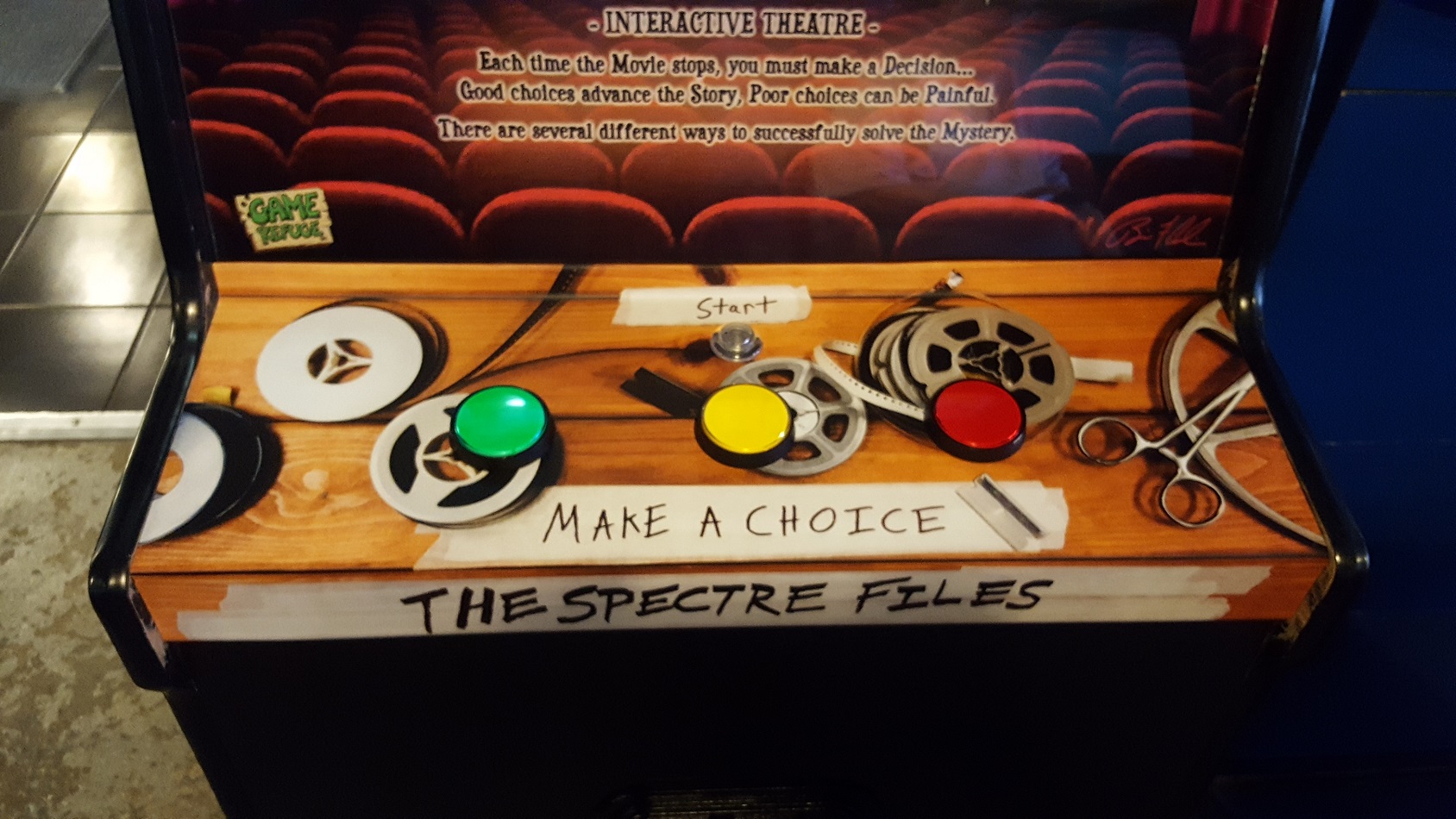
In the end, Colin is very happy to have finally gotten his decades-long horror game out to the public. “Everybody I talk to comes up to me and talks about either watching it or not being able to get on it because someone else is playing it all night. That’s very gratifying.”

THE SPECTRE FILES: DEATHSTALKER is available exclusively at Galloping Ghost Arcade, at 9415 Ogden Ave in Brookfield, IL. Follow them on Facebook here, and find Brian Colin’s Game Refuge here!
- JIM WYNORSKI RETURNS WITH THE CREATURE FEATURE ‘GILA’ - May 1, 2014
Tags: Chicago, Horror, Video Games

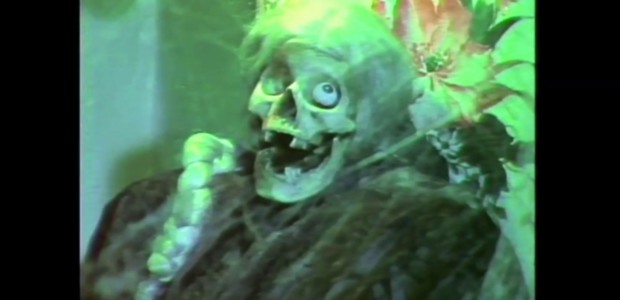

Nicely done Paul! That sounds amazing, I’d love to get my hands on it. I read all the gaming mags back then and I don’t think I ever even heard of that one. For once the clickbait don’t lie.
Thanks! I love bringing things like this to an audience!
Wow Paul, great article! I had no idea you were going to go into so much detail… I always worry that I tend to ramble on too much when asked about my games, but in this case it made for a really in-depth story… Thanks!
Thanks so much, sir! You were a pleasure to talk to, and I would have picked your brain for hours if I’d been able to!